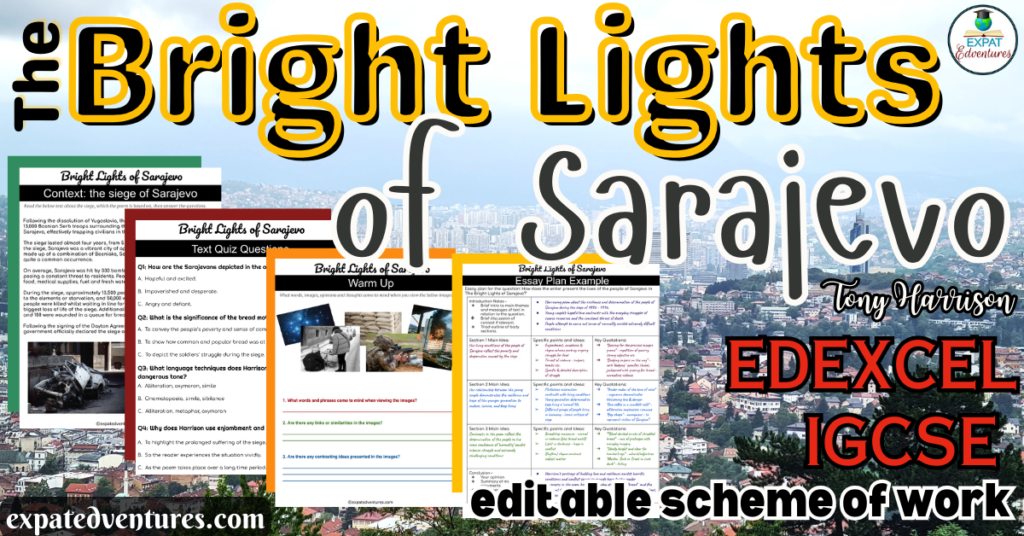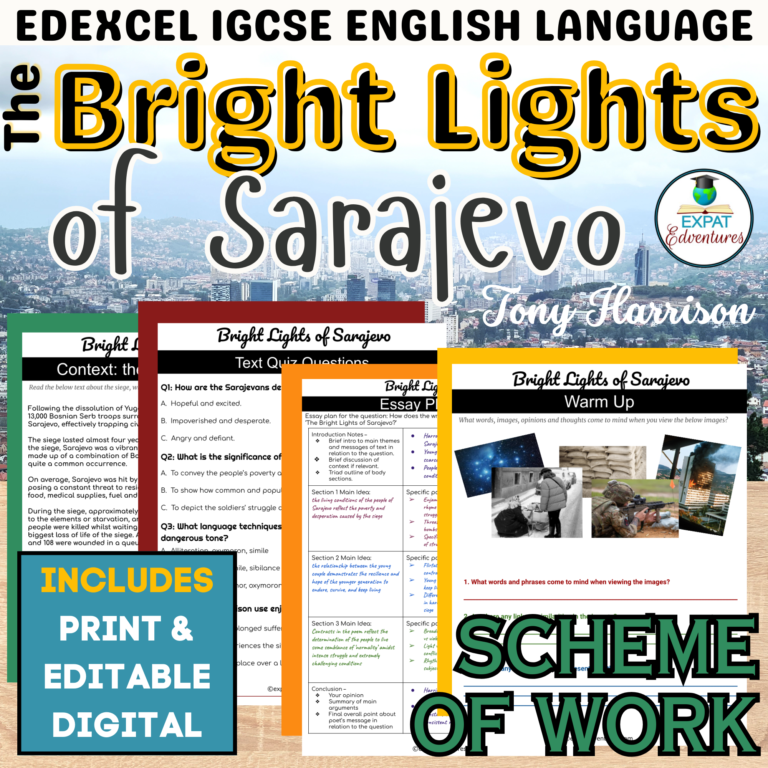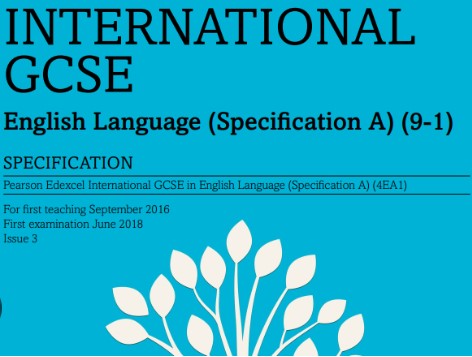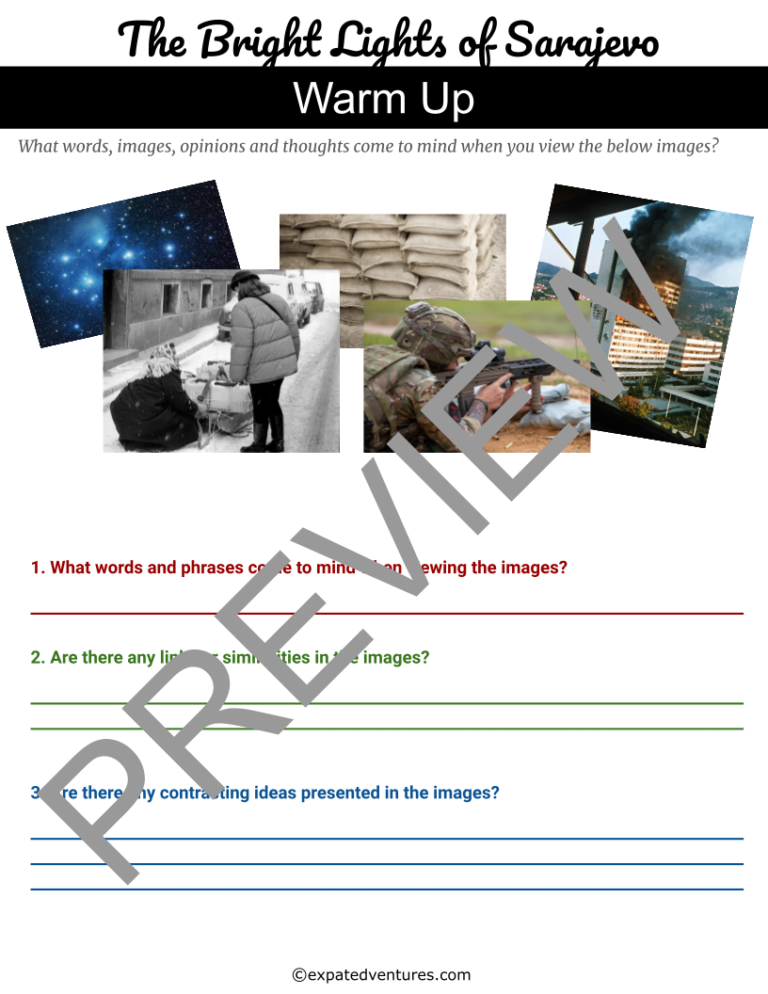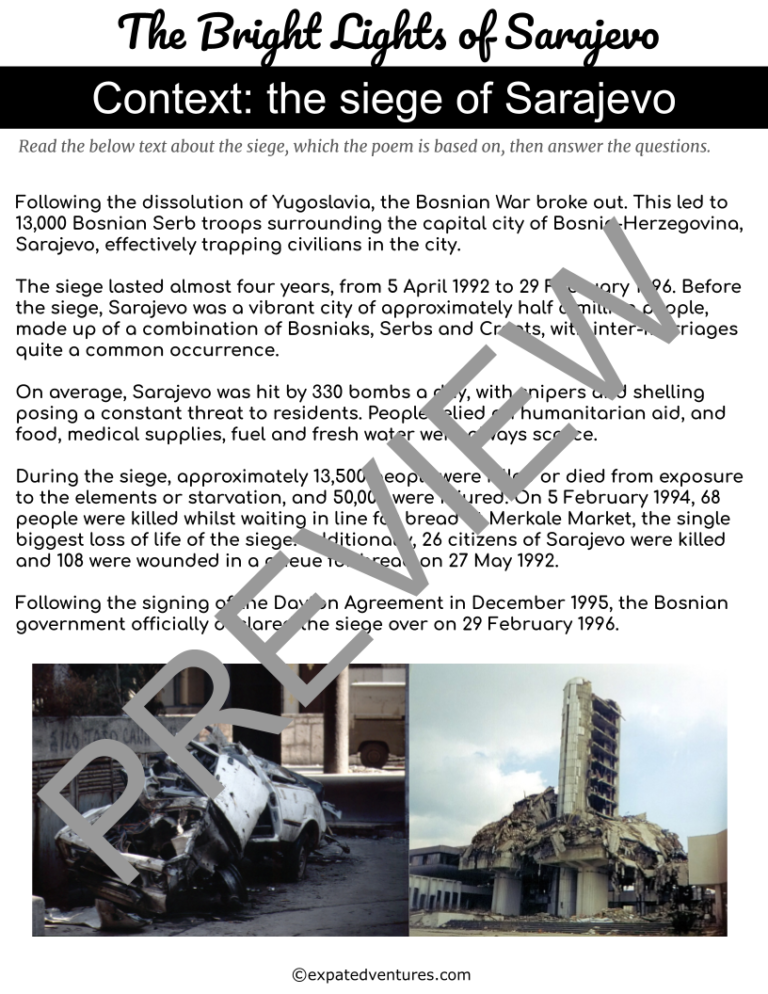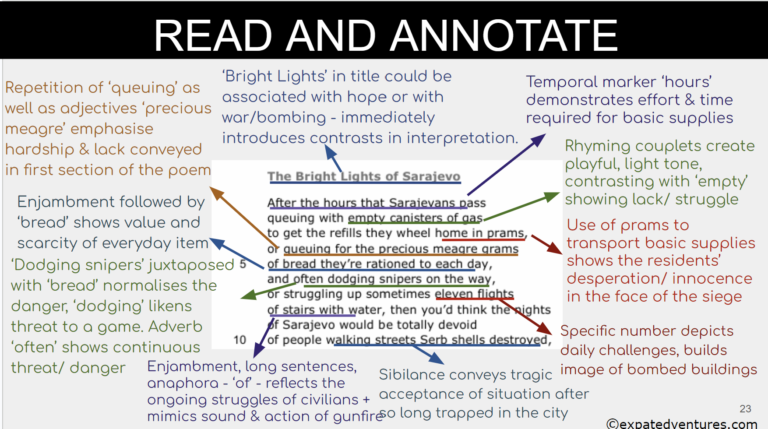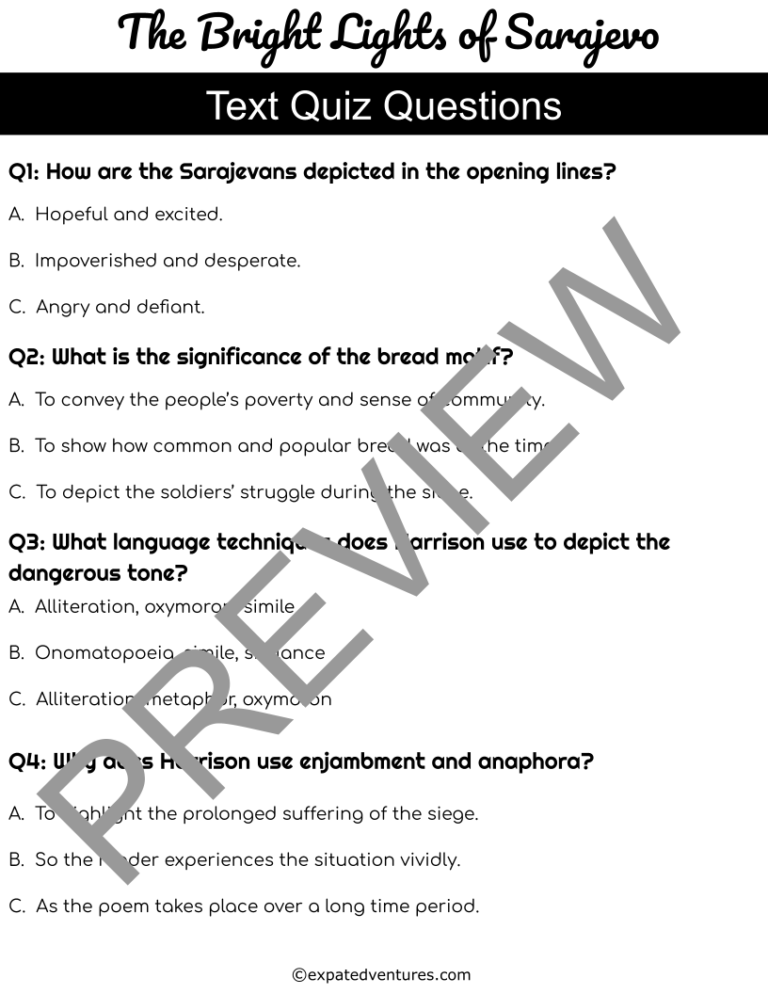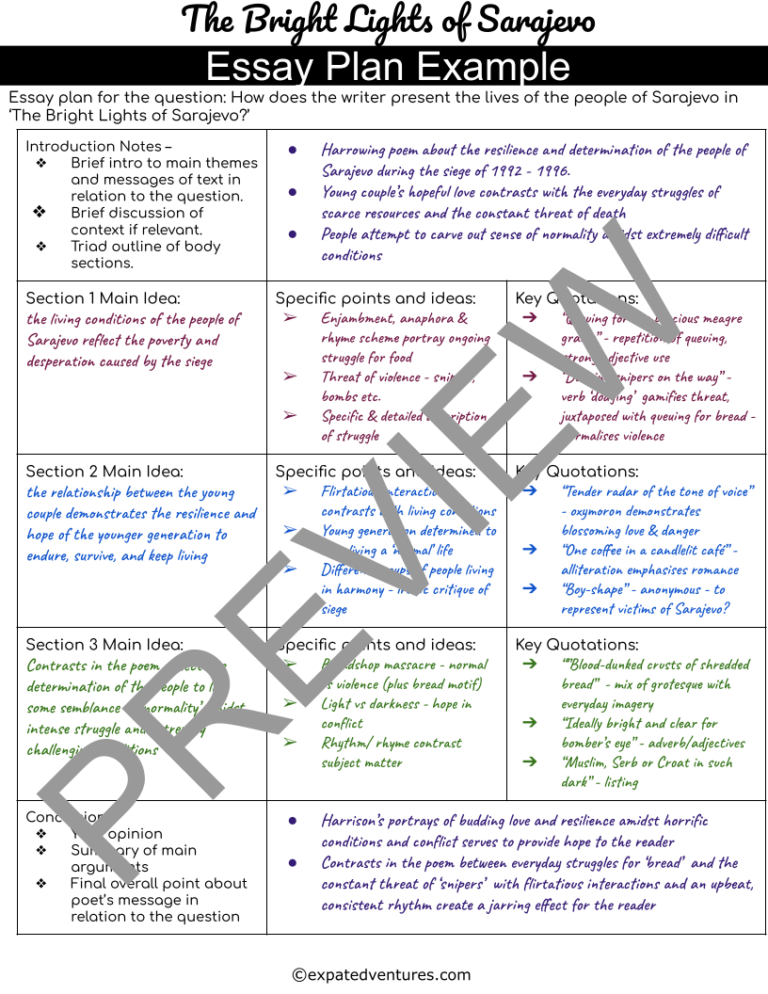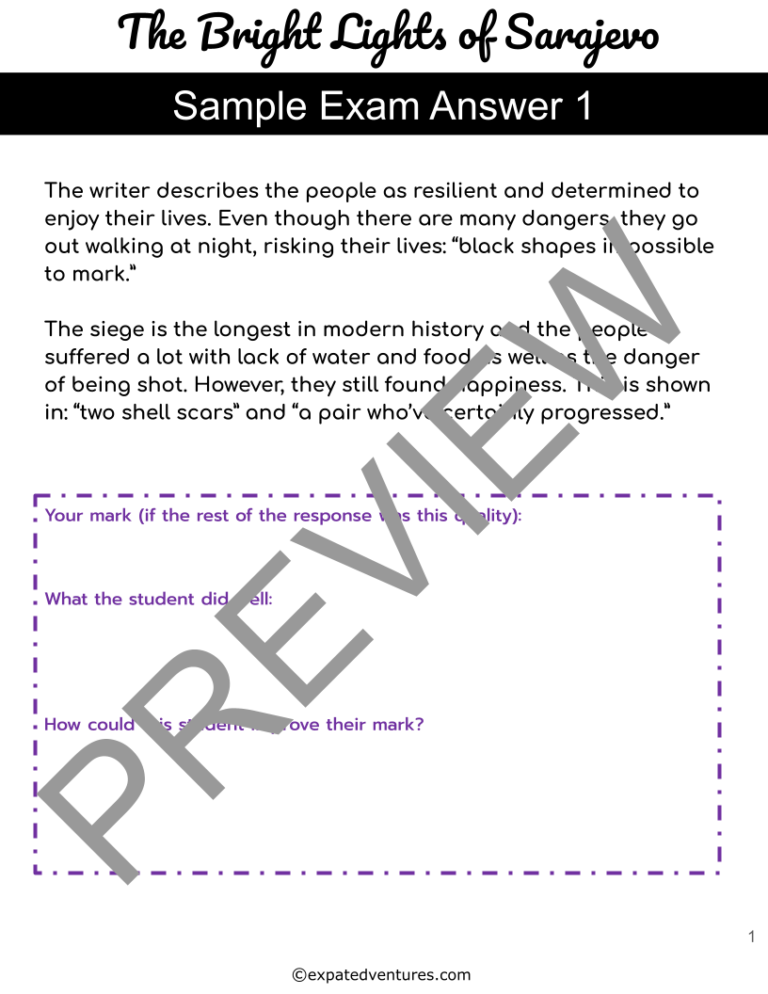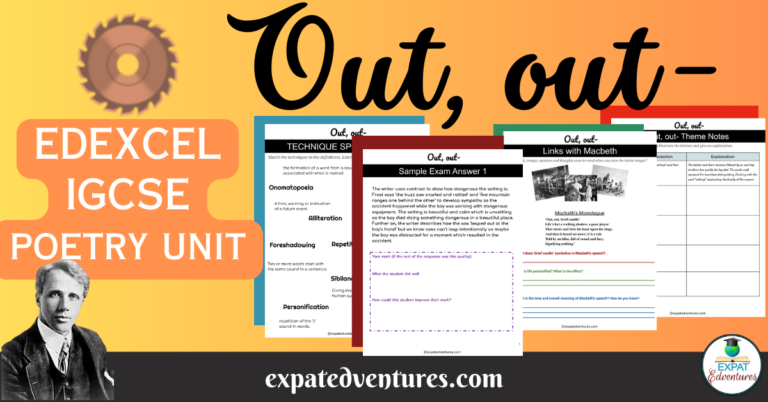The poem The Bright Lights of Sarajevo by Tony Harrison is currently taught on the Edexcel GCSE/IGCSE English Language Paper 2 curriculum. It is one of the 10 prose and poetry anthology texts which students answer on for Question 1. This poetry unit includes The Bright Lights of Sarajevo IGCSE resources, comprising a completed annotated text, quiz questions with an answer key, a rubric and example answers for students to mark.
The Bright Lights of Sarajevo is a harrowing poem about the resilience of the residents of the Sarajevo in the wake of the longest siege in modern history, lasting from 1992 to 1996. Indeed, a budding romance conveys a sense of hope amidst a daily struggle for essential supplies and under the constant threat of death.
Tony Harrison uses a mixture of desperation, fear and flirtatious romance to convey his message of resilience. But how can we support students to capture that in their exam essays? How can we break it down to consider Harrison’s ironic critique of the siege? These IGCSE resources can support your students to explore and analyse the poem in depth.
The Bright Lights of Sarajevo IGCSE Poetry Unit of Work
I’ve created a scheme of work for busy teachers to take you step-by-step through the poem. These The Bright Lights of Sarajevo IGCSE resources contain everything from an engaging, thought-provoking starter, to identifying language techniques. Also, there’s analysis and line-by-line annotations of the poem, as well as exam practice. Overall, this resource contains editable Google slides, quizzes with answer keys, sample exam questions, and example exam answers. All activities are ready to download and print in PDF form or there are links for you to personalise them if you wish.
Edexcel IGCSE English Language Exam Paper 2
The 1 hour 30 minutes Edexcel IGCSE English Language Paper 2 exam is split into Section A and Section B. Section A is the reading assessment and candidates are presented with one of the 10 prose and poetry anthology texts. The prose texts are between 1.5 and 3.5 pages long and the texts are approximately 1 page. They have 1 30-mark question to answer, which is usually based on a broad theme from the selected text, such as death, strong emotions, sympathy or conflict. Furthermore, candidates are provided with 3 bullet points which give guidance as to what to include in the response.
Section B is an imaginative writing assessment. Candidates choose between three options, which are normally loosely based on the Section A text.
· Question 2 tends to be a personal question. For example, write about a time you overcame a challenge. The response can be real or imagined.
· Question 3 tends to give the title of a story, and candidates are required to write the story.
· Question 4 usually provides a set of 2-3 images which students may use as a stimulus to write a story.
The Bright Lights of Sarajevo Poem Meaning
To introduce the poem The Bright Lights of Sarajevo, I show students images from the poem. Then, I hold a quick class discussion to talk about the connections and contrasts between the images. Next, we discuss the context of the siege. Although context isn’t specifically assessed in this exam, it’s useful for students to understand the references and allusions in the poem. There is a summary of the siege with quiz questions included with these The Bright Lights of Sarajevo IGCSE resources.
The Bright Lights of Sarajevo Poetry Techniques
Before diving into the text, I quickly review language techniques in the poem so that they are fresh in students’ minds. Students match the definition and technique, which they can either copy, cut and paste or simply number. As an extension, students can write their own examples of the techniques. This is also a useful revision tool for any GCSE poetry exam. When they know the language techniques implicitly, they naturally refer to them in their analysis and raise their marks.
The Bright Lights of Sarajevo line-by-line annotations
Before close textual analysis, I often ask students to do an initial reading or simply listen to the poem for the tone and literal reading. It is a fairly straightforward poem for students to understand on a surface level – a description of a budding romance amidst the struggles of the siege. The challenge comes in unpacking how Harrison uses language to convey an ironic critique of the reasons behind the siege. Moreover, the harmony, community, and resilience of the younger generation in the face of the division of Yugoslavia.
When it comes to closely analysing the lines of the poem, there are a few ways of approaching the activity. You can read and annotate together with students completing the line-by-line annotations in real time. Alternatively, you can split students into groups and ask each group to focus on a certain number of lines before feeding back to the class. Or you could read and discuss, then ask students to complete the annotations for homework.
There are many ways of approaching close textual analysis. I find that varying the method for different texts keeps students interested through the unit. For poems specifically, I tend to do annotations as a class activity as poetry can be more abstract and harder for students to grasp than prose texts. These The Bright Lights of Sarajevo IGCSE resources contain detailed annotations of the whole poem.
Edexcel The Bright Lights of Sarajevo Questions and Answers
After analysing the poem, I do a quick AFL quiz with students to assess their understanding of the language and structure of the poem. Then, introduce exam practice questions. Quiz questions for a straightforward low stakes multiple choice quiz with answers are available on the slides and in PDF form with this resource. Depending on your time and the nature of your class, you can do this as a whole class activity on the interactive whiteboard. Alternatively, you could hand out the worksheet for students to do in pairs or individually.
The Bright Lights of Sarajevo past paper exam practice
Question 1 on the IGCSE English Language Paper 2 exam is a 30-mark question on one of the 10 anthology prose and poetry texts. You can find them in Part 2 of the anthology. Although it is 1 question, it is quite high stakes as students don’t have anywhere to hide. Therefore, they must perform on this question. I reinforce to them that they must know all 10 of the texts very well to write a detailed essay on just one of them in the exam.
In these The Bright Lights of Sarajevo IGCSE resources, there is a rubric, paragraph sorting and structure activity and example answers for students to mark. I have also included an essay planning scaffold, including sections for students to write notes and quotes on various themes and techniques.
Edexcel IGCSE The Bright Lights of Sarajevo Essay Examples
For the question 1 past paper prompt, firstly, take students through the rubric so that they familiarise themselves with how the response is awarded. Then, you can take students through the example PETER paragraph (point, evidence, technique, explain, refer). If you wish, you can ask them to order the parts of the example paragraph, so they grapple with the concept of a cohesive paragraph. This way, there are scaffolds in place to support students to produce high quality responses and you can demonstrate how the paragraph hits the mark scheme pointers, such as exploring techniques and use of vocabulary for effect. It also directly links to the question, which is something examiners look for.
Included in these The Bright Lights of Sarajevo IGCSE resources, I have provided three example exam responses of varying quality. For each response, ask students to put themselves in the examiner’s shoes and mark the answer using the rubric. Then, students can explain what the answer did well and areas to improve. As an extension, students can develop the weakest example answer. Hold a class discussion about the answers before revealing the examiner’s marks (included in the notes on the slides).
Essentially, to be awarded full marks, there should be evidence of perceptive analysis. I explain to students that the answer goes beyond ‘obvious’ points and draws out the writer’s range of feelings and relation to the reader. Consider whether the writer changes their perspective and how language and structure connect for effect, for example a long syndetic list can also contain strong, emotive verbs. Quotations must be relevant to the points made for a student to be placed in the top band of the mark scheme. Also, multiple quotations should be used through the response.
Edexcel GCSE English Language Imaginative Writing Practice
There are also a couple of creative activities included in this resource. Time-permitting, this is a fantastic text to base a creative or transactional writing piece around. As it contains such strong and contrasting ideas and themes, you could ask students to write an imaginative piece based on the poem. Alternatively, you could ask students to write an article reporting on the siege. Doing this will help them develop a deeper knowledge of the poem itself. In addition, it can help develop skills required for Section B of Paper 1 (Transactional Writing) and Section B of Paper 2 (Imaginative Writing).
Edexcel GCSE Poetry Revision
To sum up, some of the best techniques for teaching the 10 prose and poetry texts include:
- Hook students with an intriguing starter activity
- Use alternative methods to closely analyse and annotate the text
- Quiz students for quick AFL strategy to assess whether they are engaging with the text
- Practise past paper questions
- Study model answers, including examples of typical mistakes students make in the exam responses
- Offer an optional creative activity as homework or an extension to challenge students’ perceptions of the text
Good luck teaching The Bright Lights of Sarajevo. It’s an empowering poem embodying hope and resilience under extremely difficult circumstances. Comment below if you can add any useful teaching and learning techniques for this text.
If you enjoyed this article about teaching Bright Lights of Sarajevo, you might also find value in my other Edexcel IGCSE English Language Paper 2 guides and resources for Whistle and I’ll come to you and Still I Rise. Additionally, I have resources available for the Edexcel IGCSE English Language Paper 1, including A Journey into Bhutan and The Explorer’s Daughter. Follow my store – new resources are uploaded frequently!

